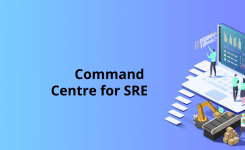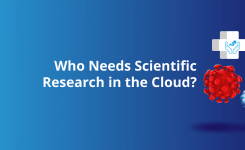2022 Blog, Digital Blog, Blog, Featured
Leveraging Microservices Architecture & Azure Platform
In our increasingly digitized world, companies across industries are embarking on digital transformation journeys to transform their infrastructure, application architecture and footprint to a more modern technology stack, one that allows them to be nimble and agile when it comes to maintainability, scalability, easier deployment (smaller units can be deployed frequently).
Old infrastructure and the traditional ways of building applications are inhibiting growth for large enterprises, mid-sized and small businesses. Rapid innovation is needed to rollout new business models, optimize business processes, and respond to new regulations.
Business leaders and employees understand the need for this agility – everyone wants to be able to connect to their Line of Business (LOB) systems through mobile devices or remotely in a secure and efficient manner, no matter how old or new these systems are, and this is where Application Modernization comes in to picture.
A very interesting use case was shared with us by our large Financial Asset management customer. They had a legacy application, which was 15+ years old and having challenges like tightly coupled business modules, code base/solution maintainability, complexity in implementing lighter version of workflow, modular way of deploying key features, legacy technology stack based application, etc. To solve this problem we had a solid envisioning phase for future state application by considering the next generation solution architecture approach, latest technology stack, value add for the business – lighter version of workflow engine, responsive design & End–to–End (E2E) DevOps solution.
Legacy Application Modernizations/Platform Re-Engineering
Legacy application modernization projects intend to create new business value from existing, aging applications by updating or replacing them with modern technologies, features and capabilities. By migrating the legacy applications, business can include the latest functionalities that better align with where business needs transformation & success.
These initiatives are typically designed and executed with phased rollouts that will replace certain functional feature sets of the legacy application with each successive rollout, eventually evolving into a complete, new, agile, modern application that is feature-rich, flexible, configurable, scalable and maintainable in future.
Monolithic Architecture Vs Microservices Architecture – The Big Picture
Monolithic Architecture
- Traditional way of building applications
- An application is built as one large system and is usually one codebase
- Application is tightly coupled and gets entangled as the application evolves
- Difficult to isolate services for purposes such as independent scaling or code maintainability
- Usually deployed on a set of identical servers behind a load balancer
- Difficult to scale parts of the application selectively
- Usually have one large code base and lack modularity. If developers community wants to update or change something, they access the same code base. So, they make changes in the whole stack at once
The following diagram depicts an application built using Monolithic Architecture
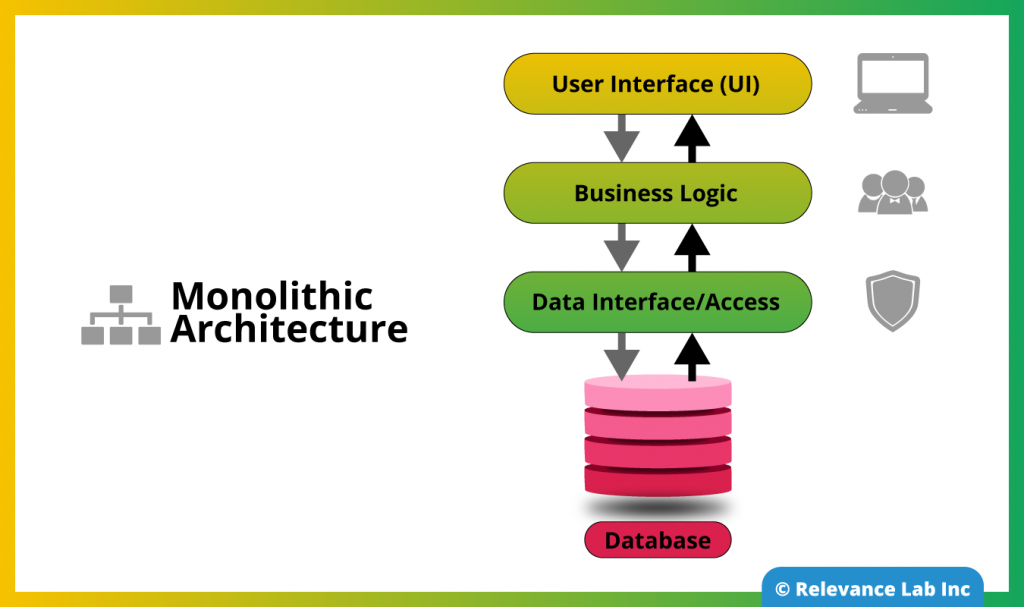
Microservices Architecture
- Modern way of building applications
- A microservice application typically consists of many services
- Each service has multiple runtime instances
- Each service instance needs to be configured, deployed, scaled, and monitored
Microservices Architecture – Tenets
The Microservices Architecture breaks the Monolithic application into a collection of smaller, independent units. Some of the salient features of Microservices are
- Highly maintainable and testable
- Autonomous and Loosely coupled
- Independently deployable
- Independently scalable
- Organized around domain or business capabilities (context boundaries)
- Owned by a small team
- Owning their related domain data model and domain logic (sovereignty and decentralized data management) and could be based on different data storage technologies (SQL, NoSQL) and different programming languages
The following diagram depicts an enterprise application built using Microservices Architecture by leveraging Microsoft technology stack.
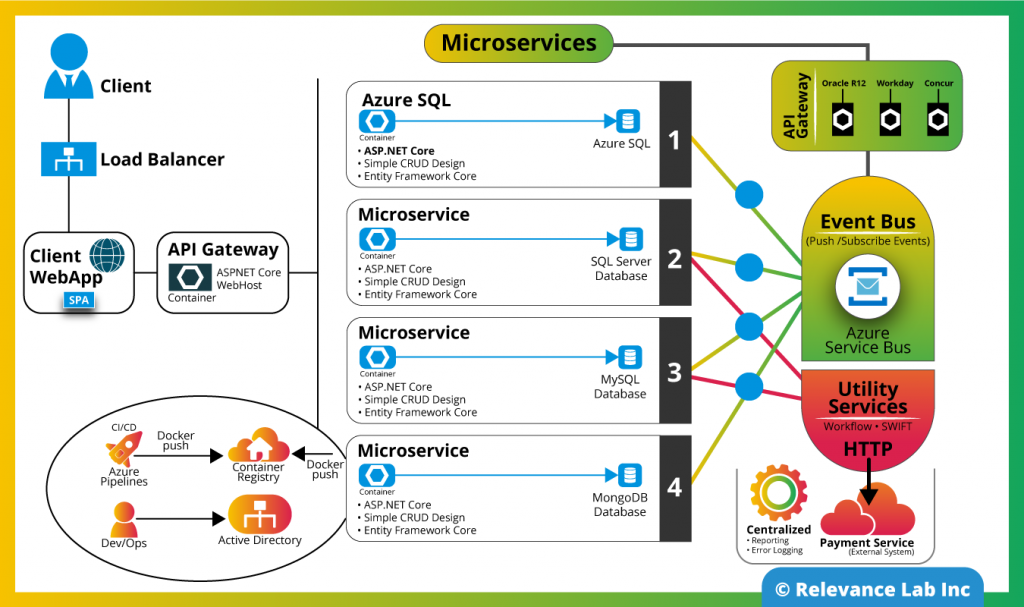
Benefits of Microservices Architecture
- Easier Development & Deployment – Enables frequent deployment of smaller units. The microservices architecture enables the rapid, frequent, and reliable delivery of large, complex applications
- Technology adoption/evolution – Enables an organization to evolve its technology stack
- Process Isolation/Fault tolerance – Each service runs in its own process and communicates with other processes using standard protocols such as HTTP/HTTPS, Web Sockets, AMQP (Advanced Message Queuing Protocol)
Today the Enterprise customers across the globe like eBay, GE Healthcare, Samsung, BMW, Boeing, etc. has been adopted Microsoft Azure platform for developing their Digital solutions. We at Relevance Lab also delivered numerous Digital transformational initiatives to our global customers by leveraging Azure platform and Agile scrum delivery methodology.
The following diagram depicts an enterprise solution development life cycle leveraging Azure platform and it’s various components, which enables Agile scrum methodology for the E2E solution delivery
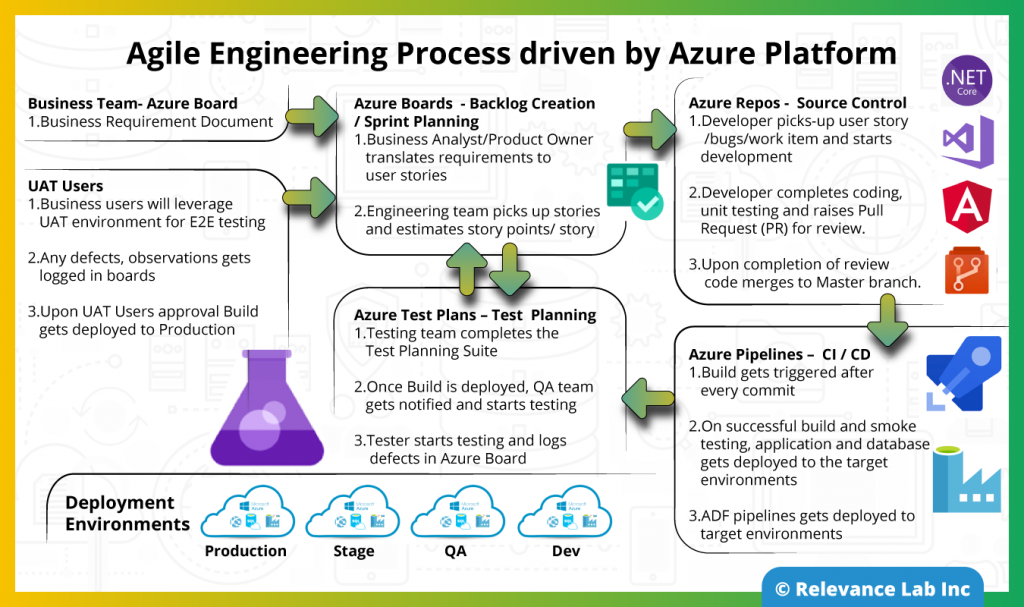
Conclusion
Monolithic Architecture does have its strengths like development and deployment simplicity, easier debugging and testing and fewer cross-cutting concerns and can be a good choice for certain situations, typically for smaller applications.However, for larger, business critical applications, the monolithic approach can bring up challenges like technological barriers, scalability, tight coupling (rigidity) and hence makes it difficult to make changes, and development teams find them difficult to understand.
By adopting Microservices architecture and Microsoft Azure Platform based solutions business could leverage below benefits
- Easier, rapid development of enterprise solutions
- Global team could be distributed to focus certain services development of the system
- Organized around business capabilities, rapid infrastructure provisioning & application development – Technology team will be focused not just on technologies but also acquires business domain knowledge, organized around business capabilities and cloud infrastructure provisioning/ capacity planning knowledge
- Offers modularizations for large enterprise applications, increases productivity and helps distributed team to focus on their specific modules and deliver them in speed and scale them based on the business growth
For more details, please feel free to reach out to marketing@relevancelab.com

